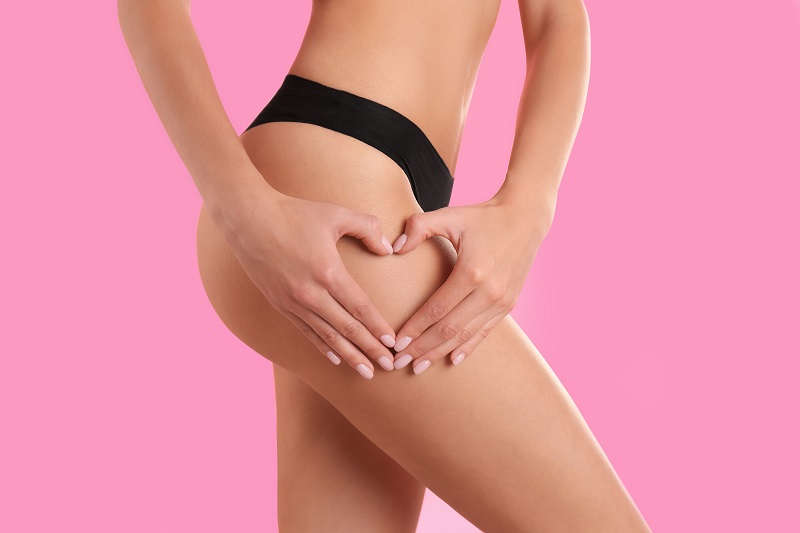When summer comes, many of us are reminded that underneath those jeans, the skin is not as smooth as we would like it to be. This is, of course, thanks to cellulite, which makes our skin look lumpy, dimply or puckered.
This article lists and explains the common causes of cellulite and provides tips on reducing the appearance of this unappealing feature.

What Is Cellulite?
Cellulite is a cosmetic skin condition that manifests as lumps or dimples on the skin’s surface. It affects as many as 9 out of 10 women and usually appears on body areas with the most fat deposits - the thighs, buttocks, hips, and belly.
Fat cells are surrounded by fibrous tissue, which connects the skin to the underlying muscles. When fat cells expand, the fibrous tissue bands pull down on the skin, making the surface of the skin appear uneven. This condition is called cellulite.
Cellulite doesn’t only affect overweight people. Weight gain and fat accumulation worsen the appearance of dimpled skin, but fat isn’t the primary cause of cellulite.
10 Causes of Cellulite
Scientists don’t clearly understand what causes cellulite, but they have several plausible theories based on existing studies. They agree that some factors are biological, making it more challenging to combat the condition. Others are lifestyle factors that require a change in habits.
1. Genetics
Genes may play a key role in cellulite formation. Scientists have identified the genes that contribute to this process, but they still know little about their mechanisms. Data shows that people with family members who have cellulite are more prone to develop it.
2. Hormones
The female hormone estrogen plays a significant role in cellulite development because it prompts the body to store fat on the thighs, hips, and buttocks in preparation for childbearing. Women typically develop cellulite during high-estrogen periods like puberty, pregnancy, and periods of using birth-control pills.
Cellulite also appears in menopause, when estrogen levels decline, because a drop in estrogen causes a reduction in collagen and elastin, a decrease in muscular tone, and impaired microcirculation.
3. Skin Structure
The difference in skin structure between men and women is another factor that makes cellulite a predominantly female problem. Women’s fibrous connective tissue bands are positioned vertically, pulling the skin down when fat cells expand, while men’s connective bands have a crisscross or lattice structure, allowing fat deposits to expand sideways without protruding into the skin. Men also have thicker skin layers than women, which additionally masks cellulite.
Note: Learn how coffee scrub for cellulite works, and how can it help reduce its appearance.
4. Aging
Aging causes a decline in the synthesis of collagen and elastin synthesis. This leads to weaker connective tissue, causes the skin to become loose and thin skin, and makes cellulite more apparent.
5. Static Lifestyle
Jobs that require sitting or standing during long hours and a lifestyle that involves little physical activity, lead to fat accumulation, water retention, loose skin – and cellulite.
To lower the risk of cellulite, introduce at least 30 minutes of moderate physical activity every day. Also, get up from your desk at least four or five times during work, take short walks, or do light exercises to flex the muscles.
Exercise improves circulation, reduces fat, and improves muscle tone, reducing the appearance of orange-peel skin.
6. Unhealthy Eating Habits
Excessive intake of refined sugars, trans fats, processed, and high-sodium foods is linked to metabolic disorders that increase the likelihood of cellulite formation.
Unprocessed foods like fruits, vegetables, whole grains, and healthy fats help the skin stay supple, reduce inflammation, and prevent fat accumulation. All of this lessens the appearance of cellulite.
7. Low Water Intake
Not drinking enough water makes it difficult to metabolize toxins in fat cells and weakens the skin, impacting the appearance of cellulite.
Health experts recommend drinking at least eight glasses of water for general well-being. The benefits of staying well hydrated include less water retention, maintaining strong connective tissue, and reducing cellulite.
8. Poor Skin and Connective Tissue Health
Collagen is the skin’s main building block. Loss of collagen results in stiffer connective tissue bands, weaker muscles, sagging skin, and more prominent cellulite dimples.
Adopting healthy lifestyle habits is the best way to maintain healthy skin and connective tissue. They include a water- and fiber-rich diet, no alcohol, daily exercise, and comprehensive skin care.
Note: Read our ultimate skin care guide for every skin type.
Sun exposure is the most detrimental factor to our skin’s health. To prevent skin and connective tissue damage and maintain smooth skin, use a broad-spectrum SPF 30+ sunscreen outdoors.
Note: Learn how to choose a sunscreen that is right for you.
9. Alcohol
Alcohol worsens the appearance of cellulite in many ways. It causes dehydration, water retention and constricts blood vessels, resulting in reduced blood flow and excess fat accumulation.
Drink alcohol in moderation. This lifestyle change will not only reduce cellulite but also improve your overall health.
10. Smoking
Studies show that a predisposition towards developing cellulite is aggravated by smoking. Like alcohol, cigarettes reduce blood vessel flow, decreasing collagen production and damaging the connective tissue.
Besides cellulite and skin quality, smoking worsens many health conditions and creates new ones. That is why medical professionals universally recommend quitting cigarettes altogether.
Conclusion
Cellulite is harmless and affects the majority of women. Nevertheless, it makes people self-conscious about their looks.
Learning what causes cellulite can help you adopt a healthier lifestyle and avoid factors that exacerbate the condition. The good news is that there are also other ways to combat this less than attractive condition.
We at Vibrant Skin Bar are proud to be able to offer the only FDA-approved anti-cellulite injectable. Treat yourself to a QWO anti-cellulite treatment and get rid of that pesky orange peel look.


